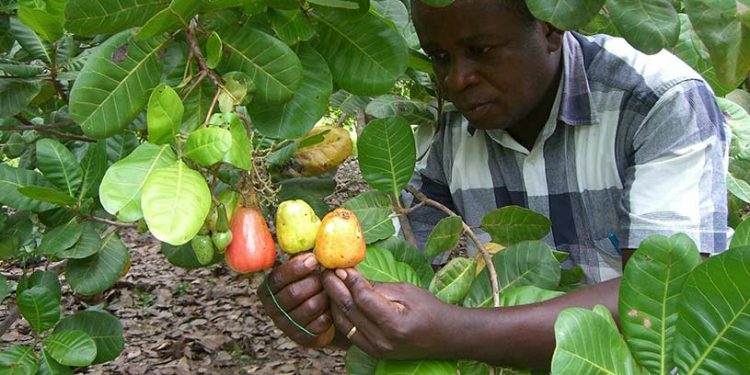The African Cashew Alliance (ACA) is projecting an increase in cashew production in Africa in 2021 despite the effects of the pandemic on the global cashew industry.
According to them, Africa is projected to exceed the over 2.1 million total c (RCNs) it produced in 2020 and will remain the greatest producer of the commodity in 2021.
A statement issued by the Alliance notes that the positive trend of production growth over the past years in West Africa is expected to continue with production estimated to be between 1.6million and 1.8 million tons of RCN by the end of the 2021 cashew season.
Cote d’ Ivoire is expected to remain the leading cashew producing country in the world, with an estimated production of 900,000 tons, close to 100,000 more than it produced last year.
Productions in Nigeria and Ghana are expected to be around the same levels as last year without
significant increase or reduction.
In Nigeria, production is expected to be between 210,000 and 250,000 tons of RCN. The ACA however emphasizes that this will be influenced by the level of cashew prices since the quantity of RCN collected in the country is often determined by where prices are.
Ghana’s production is projected to be between 110,000 and 130, 000 tons of raw cashew, around the same levels as in 2020 and in 2019.
The ACA, however, expects significant growth in cashew production in Ghana and for the country to have a fair share of the cashew market in the coming years due to concerted efforts by the government and stakeholders in recent years towards reorganizing and regulating the cashew sector including the establishment of the Tree Crops Development Authority (TCDA) and the Cashew Council Ghana (CCG).
In East Africa, the ACA projects a lower production than expected growth in 2021, especially in the two leading cashew producing countries in the sub region, Tanzania, and Mozambique, due to changes in weather, the cyclone, and the impact of security emergency in the sub region. Production in Tanzania could fall to as low as 225,000 tons by the end of the year.
Total global production is expected to be between 3.5millon and 3.8million tons and expected to meet the increasing global demand for cashew, especially in Europe and America.
Africa will produce 54% of global production with 21% coming from India. Vietnam and Cambodia are projected to produce 17%, Brazil producing 4% and the remaining 4% to be produced by other small cashew producing areas.
Demand and consumption
The ACA expects the positive trend of increasing demand and consumption of cashew kernel since 2011 to continue and remain strong in 2021, especially in Europe and America.
The United States, the largest import market for cashew in the world, ended 2020 with an incredible cashew import growth of 8%, the highest in ten years, and is expected to remain positive in 2021 regardless of the pandemic.
The European cashew market also had an incredible growth of 17% in demand, import, and consumption of cashew in 2020, following from a 15% growth in 2019. Cashew Consumption increased from a little more than 140,000 tons in 2019 to over 160,000 tons at the end of 2020.
Despite remaining second to the US market, the European market has grown from 75% in 2015 to 98% of the size of the US market in 2020. The ACA expects the demand and consumption of cashew in Europe to remain strong in 2021.
In India, though demand and consumption in 2019 stayed around 300,000 tons, with a slight decrease in 2020 due to market destructions including the pandemic, demand was not badly affected as was feared at the beginning of the pandemic. The ACA expects the Indian market to recover in 2021.
There has also been a strong positive development in demand and consumption of cashew in China and this is expected to continue in 2021.
In general, the ACA expects global demand and consumption of cashew to continue to be strong in 2021.
Processing and Supply
Vietnam ended 2020 as the world’s greatest supplier of cashew kernel, increasing processing by about 11%. The ACA projects processing and export to continue strongly in Vietnam.
In Africa, the ACA anticipates more investment into the cashew processing sector as an attempt to
shorten the cashew supply chain by processing closer to the origin. It expects factories to adopt improved and mechanized systems to enable them to process at improved capacities.
The ACA, therefore, expects more processing in Africa, especially in Cote d’ Ivoire, Nigeria, and Benin.
Other Projections
The ACA also expects proper regulatory developments in the cashew industry in Africa, especially in Ghana and Benin. The establishment of the TCDA in Ghana for instance will bring about proper regulation and organization of the industry.
More countries are also expected to show more commitment towards
developing the cashew industry by putting in place the necessary regulatory structures.
The ACA further expects the proper regulation of the industry in African countries to result in more
realistic farmgate prices in 2021.
In general, the ACA projects West Africa to remain the main driver of the global cashew industry in terms of production, Cote d’ Ivoire to remain the leading cashew producing country in the world, and a lower than-expected production in East Africa.
Possible Disruptions
Despite the relatively less impact that Covid 19 has so far had on the cashew industry. Some countries are beginning to have surge in the number of cases and travel and movement restrictions are being reintroduced.
The extent to which this continues may disrupt the cashew market. The ACA also takes into
consideration the long-term economic impacts the pandemic may have on countries, especially
developing countries in Africa.







